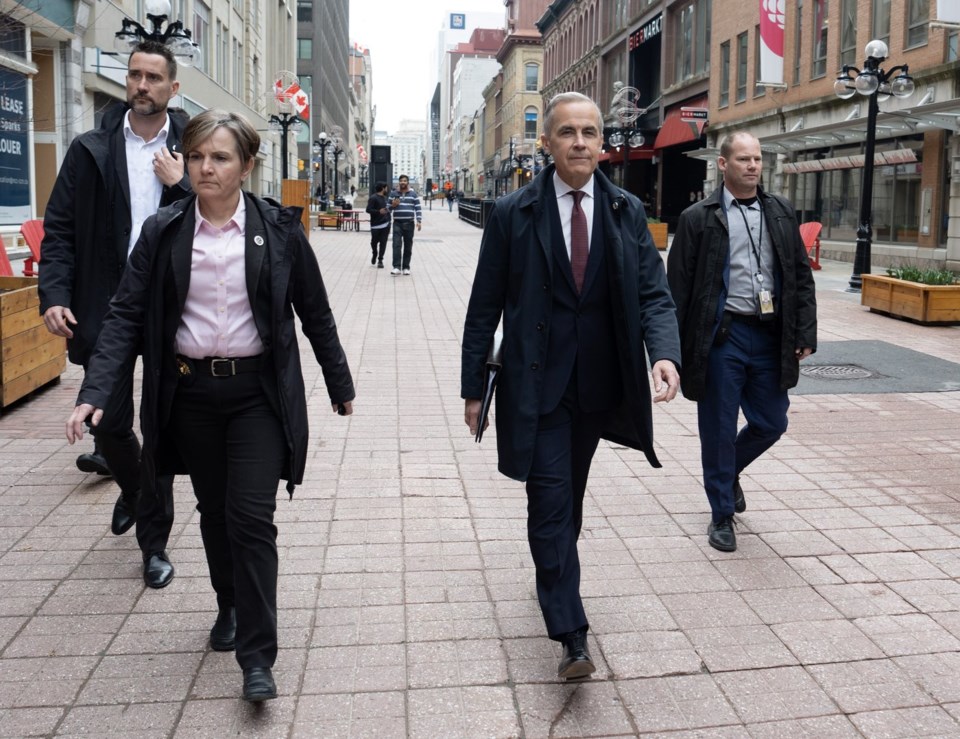WASHINGTON — Prime Minister Mark Carney will be watched closely by Canadians infuriated by Donald Trump — and by an anxious business community looking for tariff relief — when he meets with the U.S. president Tuesday in Washington.
After months of Trump's annexation threats, the newly elected prime minister will be tasked with a delicate balancing act — showing strength while maintaining Canada's place in a critical North American trade pact the president's tariffs have sought to upend.
"My government will fight to get the best deal for Canada," Carney said Friday in his first news conference since the election.
The Canada-U.S.-Mexico Agreement on trade, called CUSMA, was negotiated during the first Trump administration. Trump at the time called it the best deal ever and Canadian officials declared it a victory for Canada.
CUSMA is up for review next year — but after Trump's return to the White House, it quickly became clear the president intended to rattle the continental trade pact.
Canada and Mexico were hit early with tariffs the president linked to the flow of fentanyl and people across the borders. U.S. government data shows a tiny volume of fentanyl is intercepted at the U.S.-Canada border. Both countries were also hit by Trump's steel, aluminum and automobile duties.
Trump's provocations included calling then-prime minister Justin Trudeau a "governor" and saying the country would be better off as a U.S. state.
While the duties alarmed America's closest neighbours, signs have emerged that the president still values CUSMA — a key achievement of his first administration.
When Trump took his trade war to the world with "reciprocal" tariffs in early April, Canada and Mexico weren't included. Trump paused the largest of those duties for 90 days, saying it would allow time to negotiate deals, but kept in place a 10 per cent universal tariff on most imports to the U.S.
"If you read the tea leaves, Canada and Mexico seem to have been set aside... Hopefully that means that the administration is going to be looking at (CUSMA) as a package,” said Laura Dawson, an expert on Canada-U.S. relations and the executive director of the Future Borders Coalition.
Tuesday's meeting could provide insights into Trump's plan for what was once one of the most stable and friendly bilateral relationships in the world. Trump last week described Carney as "a very nice gentleman" and said he expects to have a "great relationship" with Canada.
United States Trade Representative Jamieson Greer hinted the Trump administration wants to maintain partnerships with its close neighbours. Greer told Fox ĂŰĚŇĘÓƵapp last week that "the president very much wants to have a healthy relationship in North America."
"We should have more manufacturing in North America — we need to have it in our hemisphere," Greer said.
But it's still not clear what Trump's team wants from Canada.
Speaking about negotiations with other countries, Greer described a "good deal" as one which sees countries drop tariff levels and remove non-tariff barriers on things like U.S. agricultural products. He said a good deal would address American concerns about digital trade and intellectual property, align export controls for economic security and offer the U.S. commercial opportunities, including investments in critical minerals.
CUSMA provided tariff-free trade for nearly all goods between Canada and the United States. The U.S. Department of Defense and Ottawa are already co-investing in Canadian critical mineral projects. Canada imposed tariffs on Chinese electric vehicles, steel and aluminum, in part to appease U.S. concerns.
Steve Verheul, Canada's former top trade negotiator, recently told the Public Policy Forum's Canada Growth Summit that the current atmosphere is similar to the tensions during the first Trump administration after the president tore up the North American Free Trade Agreement, which was replaced by CUSMA.
Verheul said the United States put forward "very extreme, completely unacceptable" proposals but Canada eventually navigated the situation by being creative and bringing forward solutions.
Although Canada is once again seeing extreme proposals, Verheul said he sees signs of Trump backing down. The president repeatedly postponed tariffs on Canada. While he went forward with the duties in March, he partially walked them back for imports compliant with CUSMA rules only a few days later.
Trump also reduced the impact of tariffs on the North American automobile sector.
Verheul said Canada is in for "a difficult negotiation" but he thinks there will ultimately be duty-free trade.
Canada must show a unified front in its talks with the administration, Dawson said. Trump has already taken notice of the Liberal minority win and said the "tight race" will make it "very complicated for the country."
Dawson said Carney should form a multi-party front on trade. During the first Trump administration, Ottawa's cross-party NAFTA advisory panel included Rona Ambrose, the former interim Conservative leader.
"There's got to be strong Conservative representation, strong regional representation, strong sectoral representation,” Dawson said.
Carney will have to be strategic, she said. Canadian businesses want room for economic growth in Canada and the U.S., but the prime minister cannot suggest that all is forgiven, Dawson added.
"There still is a lot of animosity in Canada," she said. "It's going to be difficult to manage a short-term crisis … with the United States as well as a long-term competitiveness challenge for Canada's domestic economy."
This report by The Canadian Press was first published May 4, 2025.
Kelly Geraldine Malone, The Canadian Press




